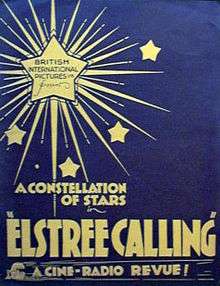Elstree Calling
| Elstree Calling | |
|---|---|
 | |
| Directed by |
Alfred Hitchcock Andre Charlot Jack Hulbert Paul Murray |
| Written by |
Adrian Brunel Walter C. Mycroft Val Valentine |
| Starring |
Teddy Brown Helen Burnell Donald Calthrop |
| Cinematography | Claude Friese-Greene |
| Distributed by | British International Pictures (UK) |
Release dates | 1930 |
Running time | 86 minutes |
| Country | United Kingdom |
| Language | English |
Elstree Calling (1930) is a film directed by Andre Charlot, Jack Hulbert, Paul Murray, and Alfred Hitchcock at Elstree Studios.
Synopsis
The film, referred to as "A Cine-Radio Revue" in its original publicity, is a lavish musical film revue and was Britain's answer to the Hollywood revues which had been produced by the major studios in the United States, such as Paramount on Parade (1930) and Hollywood Revue of 1929. The revue has a slim storyline about it being a television broadcast. The film consists of 19 comedy and music vignettes linked by running jokes of an aspiring Shakespearean actor and technical problems with a viewer's TV set.
Hitchcock's contribution was the comic linking segments about a man trying to "tune in" the revue on his television set, but always failing to get the picture for long because of his needless tinkering. (In the UK, John Logie Baird's work in mechanical television in the 1920s made television a topical subject at the time.)
Production background
Imitating the lavish use of Technicolor by Hollywood studios at that time, two sequences in the film were artificially coloured by the Pathécolor process, which used stencils to tint selected areas of the black-and-white prints.
In their book Film's musical moment, Ian Conrich and Estella Tincknell write:
- "The British equivalent of Hollywood's all-star revues was Elstree Calling (1930), produced by British International Pictures (BIP), which consisted mainly of musical and comedy items from stage shows of the day introduced by compère Tommy Handley. Lacking the lavish production values and visual spectacle of its Hollywood equivalents, Elstree Calling is now something of a curio item interesting chiefly for two reasons: Alfred Hitchcock (then contracted to BIP) was one of several directors employed on the production; and the film is quite possibly the first ever to refer directly to television (the linking narrative concerns a television broadcast of the revue, some six years before the BBC began regular television transmissions)."[1]
Cast
- Teddy Brown
- Helen Burnell
- Donald Calthrop
- Bobbie Comber
- Cicely Courtneidge
- The 3 Eddies
- Will Fyffe
- Tommy Handley
- Gordon Harker
- Jack Hulbert
- Hannah Jones
- John Longden
- Ivor McLaren
- Lily Morris
- Nathan Shacknovsky
- John Stuart
- Gordon Begg
- Jameson Thomas
- Anna May Wong